Techno-Economic Optimal Sizing Design for a Tidal Stream Turbine–Battery System
Abstract
1. Introduction
2. System Study and Method Description
2.1. Tidal Stream Turbine–Battery Modeling
2.1.1. Tidal Current Velocity Modeling
2.1.2. Tidal Power Modeling
2.1.3. Generator Modeling
2.1.4. Battery Modeling
2.1.5. Inverter Modeling
2.2. Tidal Stream TurbineBattery Control
2.3. Method Description
2.3.1. Energy Management Strategy
- Charging process: When the tidal energy exceeds the load demand (, the TST will therefore supply the load, while the energy surplus will charge the battery until .
- Discharging process: When the TST energy is insufficient to cover the load demand , whilst the battery is properly charged , the energy deficit is covered by the battery.
2.3.2. Optimal Sizing Approach
Reliability Indexes
- Deficiency of Power Supply Probability
- Relative Excess Power Generated
Economic Indexes
- Total Net Present CostThe TNPC includes (capital cost), (operation and maintenance cost), and (replacement cost) [78]:
- Capital cost: It represents the used component procurement cost sum (TST, battery, and inverter) [79];
- Operation and maintenance cost: It represents all the system component operation and maintenance costs during the year. It depends on the system lifetime and the interest rate [79];
- Replacement cost: It depends on some component replacement.
- Energy Cost
2.3.3. Proposed Sizing Approach
- Input the following over a year: the load power, the tidal velocity, and the battery minimal and maximal states of charge;
- If the energy obtained from the tidal source exceeds the current load, the surplus of energy is stored in the battery. Then, the new state of charge is determined using Equation (5);
- If the load demand exceeds the energy produced by tidal source, the battery will be used to meet the load demand. Then, the new state of charge is obtained using Equation (5);
- Size the system’s different components that ensure system reliability (DPSP = 0) over a year with minimal EC and TNPC, and EC;
- Stop when cost is minimal, with zero DPSP;
- Save the obtained (TST power, battery capacity) configuration.
3. Results and Discussion
4. Conclusions
Author Contributions
Funding
Conflicts of Interest
References
- Chen, H.; Tang, T.; Aït-Ahmed, N.; Benbouzid, M.E.H.; Machmoum, M.; Zaïm, M.E.H. Attraction, challenge and current status of marine current energy. IEEE Access 2018, 6, 12665–12685. [Google Scholar] [CrossRef]
- Zhou, Z.; Benbouzid, M.E.H.; Charpentier, J.F.; Scuiller, F. Hybrid Diesel/MCT/Battery Electricity Power Supply System for Power Management in Small Islanded Sites: Case Study for the Ouessant French Island. In Smart Energy Grid Design for Island Countries: Challenges and Opportunities; Islam, F.M.R., Mamun, K.A., Amanullah, M.T.O., Eds.; Green Energy and Technology Series; Springer International Publishing: Cham, Switzerland, 2017; pp. 415–445. [Google Scholar]
- Mohammed, O.H.; Amirat, Y.; Benbouzid, M.E.H.; Feld, G. Optimal Sizing and Energy Management of Hybrid Wind/Tidal/PV Power Generation System for Remote Areas: Application to the Ouessant French Island. In Smart Energy Grid Design for Island Countries: Challenges and Opportunities; Islam, F.M.R., Mamun, K.A., Amanullah, M.T.O., Eds.; Green Energy and Technology Series; Springer International Publishing: Cham, Switzerland, 2017; pp. 381–413. [Google Scholar]
- Zia, M.F.; Nasir, M.; Elbouchikhi, E.; Benbouzid, M.E.H.; Vasquez, J.C.; Guerrero, J.M. Energy management system for a hybrid PV-wind-tidal-battery-based islanded DC microgrid: Modeling and experimental validation. Renew. Sustain. Energy Rev. 2022, 159, 112093. [Google Scholar] [CrossRef]
- Ben Elghali, S.; Outbib, R.; Benbouzid, M.E.H. Selecting and optimal sizing of hybridized energy storage systems for tidal energy integration into power grid. J. Mod. Power Syst. Clean Energy 2019, 7, 113–122. [Google Scholar] [CrossRef]
- El Tawil, T.; Charpentier, J.F.; Benbouzid, M.E.H. Sizing and rough optimization of a hybrid renewable-based farm in a stand-alone marine context. Renew. Energy 2018, 115, 1134–1143. [Google Scholar] [CrossRef]
- Lazaar, N.; Fakhri, E.; Barakat, M.; Gualous, H.; Sabor, J. Optimal sizing of Marine Current Energy Based Hybrid Microgrid. In Proceedings of the 18th International Conference on Renewable Energies and Power Quality, Granada, Spain, 1–2 April 2020. [Google Scholar]
- Procter, A.; Zhang, F.; Jon Maddy, J. Control of a Tidal Lagoon Power Generation Hydrogen Storage System. In Proceedings of the IEEE International Conference on Control (CONTROL), Plymouth, UK, 20–22 April 2022. [Google Scholar]
- Testa, A.; De Caro, S.; Scimone, T. Analysis of a VRB energy storage system for a tidal turbine generator. In Proceedings of the IEEE European Conference on Power Electronics and Applications, Barcelona, Spain, 8–10 September 2009. [Google Scholar]
- Lian, J.; Zhang, Y.; Ma, C.; Yang, Y.; Chaima, E. A review on recent sizing methodologies of hybrid renewable energy systems. Energy Manag. Convers. 2019, 199, 112027. [Google Scholar] [CrossRef]
- Olcan, C. Multi-objective analytical model for optimal sizing of stand-alone photovoltaic water pumping systems. Energy Manag. Convers. 2015, 100, 358–369. [Google Scholar] [CrossRef]
- Ekren, O.; Ekren, B.Y. Size optimization of a PV/wind hybrid energy conversion system with battery storage using simulated annealing. Appl. Energy 2010, 87, 592–598. [Google Scholar] [CrossRef]
- Chen, H.C. Optimum capacity determination of stand-alone hybrid generation system considering cost and reliability. Appl. Energy 2013, 103, 155–164. [Google Scholar] [CrossRef]
- Anoune, K.; Bouya, M.; Astito, A.; Ben Abdallah, A. Sizing methods and optimization techniques for PV-wind based hybrid renewable energy system: A review. Renew. Sustain. Energy Rev. 2018, 93, 652–673. [Google Scholar] [CrossRef]
- Kumar, R.; Gupta, R.A.; Bansal, A.K. Economic analysis and power management of a stand-alone wind/photovoltaic hybrid energy system using biogeography based optimization algorithm. Swarm Evol. Comput. 2013, 8, 33–43. [Google Scholar] [CrossRef]
- Portero, U.; Velázquez, S.; Carta, J.A. Sizing of a wind-hydro system using a reversible hydraulic facility with seawater. A case study in the Canary Islands. Energy Manag. Convers. 2015, 106, 1251–1263. [Google Scholar] [CrossRef]
- Khare, V.; Nema, S.; Baredar, P. Optimisation of the hybrid renewable energy system by HOMER, PSO and CPSO for the study area. Int. J. Sustain. Energy 2017, 36, 326–343. [Google Scholar] [CrossRef]
- Tezer, T.; Yaman, R.; Yaman, G. Evaluation of approaches used for optimization of stand-alone hybrid renewable energy systems. Renew. Sustain. Energy Rev. 2017, 73, 840–853. [Google Scholar] [CrossRef]
- Maleki, A.; Khajeh, M.G.; Ameri, M. Optimal sizing of a grid independent hybrid renewable energy system incorporating resource uncertainty, and load uncertainty. Int. J. Electr. Power Energy Syst. 2016, 83, 514–524. [Google Scholar] [CrossRef]
- Lan, H.; Wen, S.; Hong, Y.Y. Optimal sizing of hybrid PV/diesel/battery in ship power system. Appl. Energy 2015, 158, 26–34. [Google Scholar] [CrossRef]
- Bortolini, M.; Gamberi, M.; Graziani, A. Economic and environmental bi-objective design of an off-grid photovoltaic–battery–diesel generator hybrid energy system. Energy Manag. Convers. 2015, 106, 1024–1038. [Google Scholar] [CrossRef]
- Abbes, D.; Martinez, A.; Champenois, G. Life cycle cost, embodied energy and loss of power supply probability for the optimal design of hybrid power systems. Math Comput. Simul. 2014, 98, 46–62. [Google Scholar] [CrossRef]
- Shi, B.; Wu, W.; Yan, L. Size optimization of stand-alone PV/wind/diesel hybrid power generation systems. J. Taiwan Inst. Chem. Eng. 2017, 73, 93–101. [Google Scholar] [CrossRef]
- Dufo-López, R.; Cristóbal-Monreal, I.R.; Yusta, J.M. Optimisation of PV-wind-dieselbattery stand-alone systems to minimise cost and maximise human development index and job creation. Renew. Energy 2016, 94, 280–293. [Google Scholar] [CrossRef]
- Paliwal, P.; Patidar, N.P.; Nema, R.K. Determination of reliability constrained optimal resource mix for an autonomous hybrid power system using particle swarm optimization. Renew. Energy 2014, 63, 194–204. [Google Scholar] [CrossRef]
- Chauhan, A.; Saini, R.P. Techno-economic feasibility study on Integrated Renewable Energy System for an isolated community of India. Renew. Sustain. Energy Rev. 2016, 59, 388–405. [Google Scholar] [CrossRef]
- Stigka, E.K.; Paravantis, J.A.; Mihalakakou, G.K. Social acceptance of renewable energy sources: A review of contingent valuation applications. Renew. Sustain. Energy Rev. 2014, 32, 100–106. [Google Scholar] [CrossRef]
- Kazem, H.A.; Khatib, T.; Sopian, K. Sizing of a standalone photovoltaic/battery system at minimum cost for remote housing electrification in Sohar, Oman. Energy Build. 2013, 61, 108–115. [Google Scholar] [CrossRef]
- Al-falahi, M.D.A.; Jayasinghe, S.D.G.; Enshaei, H. A review on recent size optimization methodologies for standalone solar and wind hybrid renewable energy system. Energy Convers. Manag. 2017, 143, 252–274. [Google Scholar] [CrossRef]
- Khatib, T.; Ibrahim, I.A.; Mohamed, A. A review on sizing methodologies of photovoltaic array and storage battery in a standalone photovoltaic system. Energy Convers. Manag. 2016, 120, 430–448. [Google Scholar] [CrossRef]
- Ayop, R.; Isa, N.M.; Tan, C.W. Components sizing of photovoltaic stand-alone system based on loss of power supply probability. Renew. Sustain. Energy Rev. 2018, 81, 2731–2743. [Google Scholar] [CrossRef]
- Fantauzzi, M.; Lauria, D.; Mottola, F.; Scalfati, A. Sizing energy storage systems in DC networks: A general methodology based upon power losses minimization. Appl. Energy 2017, 187, 862–872. [Google Scholar] [CrossRef]
- Luna-Rubio, R.; Trejo-Perea, M.; Vargas-Vazquez, D.; Rios-Moreno, G.J. Optimal sizing of renewable hybrids energy systems: A review of methodologies. Sol. Energy 2012, 86, 1077–1088. [Google Scholar] [CrossRef]
- Markvart, T. Sizing of hybrid photovoltaic-wind energy systems. Sol. Energy 1996, 57, 277–281. [Google Scholar] [CrossRef]
- Chauhan, A.; Saini, R.P. A review on integrated renewable energy system based power generation for stand-alone applications: Configurations, storage options, sizing methodologies and control. Renew. Sustain. Energy Rev. 2014, 38, 99–120. [Google Scholar] [CrossRef]
- Clúa, J.G.G.; Mantz, R.J.; De Battista, H. Optimal sizing of a grid-assisted wind-hydroge system. Energy Convers. Manag. 2018, 166, 402–408. [Google Scholar] [CrossRef]
- Upadhyay, S.; Sharma, M.P. A review on configurations, control and sizing methodologies of hybrid energy systems. Renew. Sustain. Energy Rev. 2014, 38, 47–63. [Google Scholar] [CrossRef]
- Zhou, W.; Lou, C.; Li, Z.; Lu, L.; Yang, H. Current status of research on optimum sizing of standalone hybrid solar-wind power generation systems. Appl. Energy 2010, 87, 380–389. [Google Scholar] [CrossRef]
- Hosseinalizadeh, R.; Shakouri, H.; Amalnick, M.S.; Taghipour, P. Economic sizing of a hybrid (PV-WT-FC) renewable energy system (HRES) for standalone usages by an optimization simulation model: Case study of Iran. Renew. Sustain. Energy Rev. 2016, 54, 139–150. [Google Scholar] [CrossRef]
- Das, M.; Singh, M.A.K.; Biswas, A. Techno-economic optimization of an off-grid hybrid renewable energy system using metaheuristic optimization approaches case of a radio transmitter station in India. Energy Convers. Manag. 2019, 185, 339–352. [Google Scholar] [CrossRef]
- Duchaud, J.L.; Notton, G.; Fouilloy, A.; Voyant, C. Wind, solar and battery micro-grid optimal sizing in Tilos Island. Energy Procedia 2019, 159, 22–27. [Google Scholar] [CrossRef]
- Mosetti, G.; Poloni, C.; Diviacco, B. Optimization of wind turbine positioning in large windfarms by means of a genetic algorithm. J. Wind. Eng. Ind. Aerodyn. 1994, 51, 105–116. [Google Scholar] [CrossRef]
- Kennedy, J.; Eberhart, R. Particle swarm optimization. In Proceedings of the IEEE International Conference on Neural Networks, Perth, WA, Australia, 27 November–1 December 1995. [Google Scholar]
- Liu, Z.; Chen, Y.; Zhuo, R.; Jia, H. Energy storage capacity optimization for autonomy microgrid considering CHP and EV scheduling. Appl. Energy 2018, 210, 1113–1325. [Google Scholar] [CrossRef]
- Maleki, A.; Ameri, M.; Keynia, F. Scrutiny of multifarious particle swarm optimization for finding the optimal size of a PV/wind/battery hybrid system. Renew. Energy 2015, 80, 552–563. [Google Scholar] [CrossRef]
- Yeghikian, M.; Ahmadi, A.; Dashti, R.; Esmaeilion, F.; Mahmoudan, A.; Hoseinzadeh, S.; Garcia, D.A. Wind Farm Layout Optimization with Different Hub Heights in Manjil Wind Farm Using Particle Swarm Optimization. Renew. Sustain. Energy Syst. 2021, 11, 9746. [Google Scholar] [CrossRef]
- Yang, X.S.; Deb, S. Engineering optimization by cuckoo search. Int. J. Math. Model. Numer. Optim. 2010, 4, 339–343. [Google Scholar]
- Nadjemi, O.; Nacer, T.; Hamidat, A.; Salhi, H. Optimal hybrid PV/wind energy system sizing: Application of cuckoo search algorithm for Algerian dairy farms. Renew. Sustain. Energy Rev. 2017, 70, 1352–1365. [Google Scholar] [CrossRef]
- Sanajaoba, S.; Fernandez, E. Maiden application of Cuckoo Search algorithm for optimal sizing of a remote hybrid renewable energy system. Renew. Energy 2016, 96, 1–10. [Google Scholar] [CrossRef]
- Yang, X.S.; Deb, S. Cuckoo search via Lévy flights. In Proceedings of the World Congress on Nature & Biologically Inspired Computing (NaBIC2009), 9–11 December 2009, Coimbatore, India; IEEE Publications: Piscataway, NJ, USA, 2009. [Google Scholar]
- Maleki, A.; Askarzadeh, A. Comparative study of artificial intelligence techniques for sizing of a hydrogen-based standalone photovoltaic/wind hybrid system. Int. J. Hydrogen Energy 2014, 39, 9973–9984. [Google Scholar] [CrossRef]
- Chiroma, H.; Shuib, N.L.M.; Muaz, S.A.; Abubakar, A.I.; Ila, L.B.; Maitama, J.Z. A review of the applications of bio-inspired Flower Pollination Algorithm. Procedia Comput. Sci. 2015, 62, 435–441. [Google Scholar] [CrossRef]
- Moghaddam, M.J.H.; Kalam, A.; Nowdeh, S.A.; Ahmadi, A.; Babanezhad, M.; Saha, S. Optimal sizing and energy management of stand-alone hybrid photovoltaic/wind system based on hydrogen storage considering LOEE and LOLE reliability indices using flower pollination algorithm. Renew. Energy 2019, 135, 1412–1434. [Google Scholar] [CrossRef]
- Samy, M.M.; Barakat, S.; Ramadan, H.S. A flower pollination optimization algorithm for an off-grid PV-fuel cell hybrid renewable system. Int. J. Hydrogen Energy 2019, 44, 2141–2152. [Google Scholar] [CrossRef]
- Saremi, S.; Mirjalili, S.; Lewis, A. Grasshopper optimisation algorithm: Theory and application. Adv. Eng. Softw. 2017, 105, 30–47. [Google Scholar] [CrossRef]
- Bukar, A.L.; Tan, C.W.; Lau, K.Y. Optimal sizing of an autonomous photovoltaic/ wind/battery/diesel generator microgrid using grasshopper optimization algorithm. Sol. Energy 2019, 188, 685–696. [Google Scholar] [CrossRef]
- Eberhart, R.; Kennedy, J. A new optimizer using particle swarm theory. In Proceedings of the Sixth International Symposium on Micro Machine and Human Science, Nagoya, Japan, 4–6 October 1995. [Google Scholar]
- Abido, M. Optimal power flow using tabu search algorithm. Electr. Power Comp. Syst. 2002, 30, 469–483. [Google Scholar] [CrossRef]
- Kirkpatrick, S.; Vecchi, M. Optimization by simulated annealing. Science 1983, 220, 671–680. [Google Scholar] [CrossRef] [PubMed]
- Koussa, D.S.; Koussa, M. A feasibility and cost benefit prospection of grid connected hybrid power system (wind-photovoltaic) Case study: An Algerian coastal site. Renew. Sustain. Energy Rev. 2015, 50, 628–642. [Google Scholar] [CrossRef]
- Cano, A.; Jurado, F.; Sanchez, H. Optimal sizing of stand-alone hybrid systems based on PV/WT/FC by using several methodologies. J. Energy Inst. 2014, 87, 330–340. [Google Scholar] [CrossRef]
- Tozzi, P., Jr.; Jo, J.H. A comparative analysis of renewable energy simulation tools: Performance simulation model vs. system optimization. Renew. Sustain. Energy Rev. 2017, 80, 390–398. [Google Scholar] [CrossRef]
- Sinha, S.; Chandel, S.S. Review of software tools for hybrid renewable energy systems. Renew. Sustain. Energy Rev. 2014, 32, 192–205. [Google Scholar] [CrossRef]
- Katsigiannis, Y.A.; Georgilakis, P.S.; Karapidakis, E.S. Hybrid simulated annealing-tabu search method for optimal sizing of autonomous power systems with renewables. IEEE Trans. Sustain. Energy 2012, 3, 330–338. [Google Scholar] [CrossRef]
- Essa, M.E.S.M.; Aboelela, M.A.S.; Hassan, M.A.M.; Abdrabbo, S.M. Design of model predictive force control for hydraulic servo system based on cuckoo search and genetic algorithms. Proc. Inst. Mech. Eng. I J. Syst. Control Eng. 2019, 234, 701–714. [Google Scholar] [CrossRef]
- Borhanazad, H.; Mekhilef, S.; Ganapathy, V.G.; Modiri-Delshad, M.; Mirtaheri, A. Optimization of micro-grid system using MOPSO. Renew. Energy 2014, 71, 295–306. [Google Scholar] [CrossRef]
- Benbouzid, M.E.H.; Astolfi, J.A.; Bacha, S.; Charpentier, J.F.; Machmoum, M.; Maître, T.; Roye, D. Concepts, Modeling and Control of Tidal Turbines. In Marine Renewable Energy Handbook; Wiley-ISTE: Paris, France, 2011; pp. 219–278. [Google Scholar]
- Barakat, M.R.; Tala-Ighil, B.; Chaoui, H.; Gualous, H.; Slamani, Y.; Hissel, D. Energetic Macroscopic Representation of a Marine Current Turbine System with Loss Minimization Control. IEEE Trans. Sustain. Energy 2018, 9, 106–117. [Google Scholar] [CrossRef]
- Touimi, K.; Benbouzid, M.E.H.; Tavner, P. Tidal stream turbines: With or without a gearbox? Ocean. Eng. 2018, 170, 74–88. [Google Scholar] [CrossRef]
- Zhou, Z.; Benbouzid, M.E.H.; Charpentier, J.F.; Scuiller, F.; Tang, T. Developments in large marine current turbine technologies—A review. Renew. Sustain. Energy Rev. 2017, 77, 852–858. [Google Scholar] [CrossRef]
- Benelghali, S.; Benbouzid, M.E.H.; Charpentier, J.F. Generator systems for marine current turbine applications: A comparative study. IEEE J. Ocean. Eng. 2012, 37, 554–563. [Google Scholar] [CrossRef]
- Toumi, S.; Amirat, Y.; Elbouchikhi, E.; Trabelsi, M.; Benbouzid, M.E.H.; Mimouni, M.F. A simplified mathematical approach for magnet defects modeling in a PMSG used for marine current turbine. In Proceedings of the 2016 17th International Conference on Sciences and Techniques of Automatic Control and Computer Engineering (STA), Sousse, Tunisia, 19–21 December 2016. [Google Scholar]
- Amara, S.; Toumi, S.; Ben Salah, C. Optimization sizing of an autonomous PV-battery microgrid system. Proc. Inst. Mech. Eng. I J. Syst. Control Eng. 2022. [Google Scholar]
- Zhou, Z.; Scuiller, F.; Charpentier, J.F.; Benbouzid, M.E.H.; Tang, T. Power control of a non-pitchable PMSG-based marine current turbine at over-rated current speed with flux-weakening strategy. IEEE J. Ocean. Eng. 2015, 40, 536–545. [Google Scholar] [CrossRef]
- Benelghali, S.; Benbouzid, M.E.H.; Charpentier, J.F.; Ahmed-Ali, T.; Munteanu, I. Experimental validation of a marine current turbine simulator: Application to a PMSG-based system second-order sliding mode control. IEEE Trans. Ind. Electron. 2011, 58, 118–126. [Google Scholar] [CrossRef]
- Mekri, F.; Benelghali, S.; Benbouzid, M.E.H. fault-tolerant control performance comparison of three-and five-phase PMSG for marine current turbine applications. IEEE Trans. Sustain. Energy 2013, 4, 425–433. [Google Scholar] [CrossRef]
- Sinha, S.; Chandel, S.S. Review of recent trends in optimization techniques for solar photovoltaic–wind based hybrid energy systems. Renew. Sustain. Energy Rev. 2015, 50, 755–769. [Google Scholar] [CrossRef]
- Bashir, M.; Sadeh, J. Size optimization of new hybrid stand-alone renewable energy system considering a reliability index. In Proceedings of the 11th International Conference on Environment and Electrical Engineering, Venice, Italy, 18–25 May 2012. [Google Scholar]
- Askarzadesh, A.; dos Santos Coelho, L. A novel framework for optimization of a grid independent hybrid renewable energy system: A case study of Iran. Sol. Energy 2015, 112, 383–396. [Google Scholar] [CrossRef]
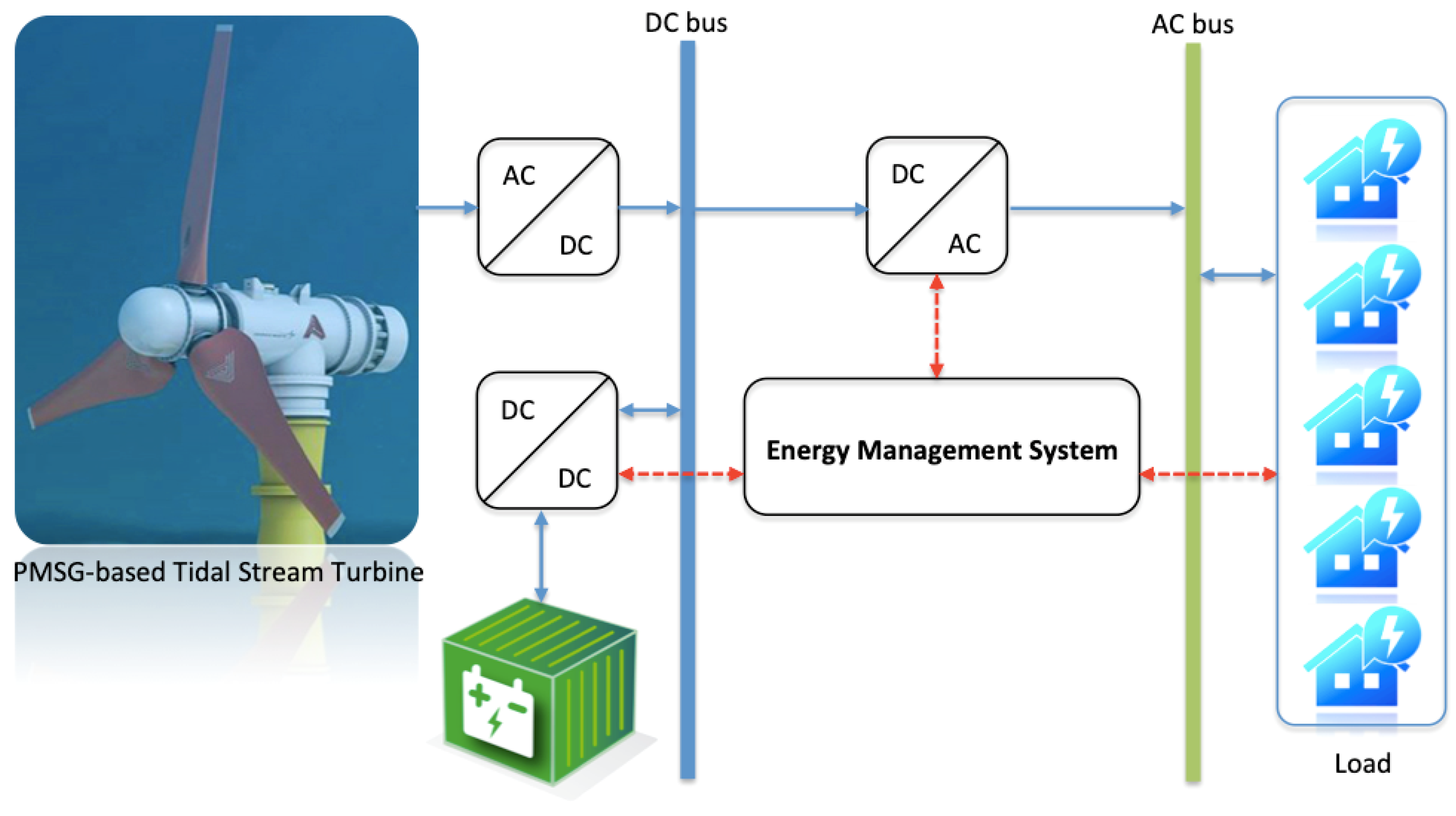
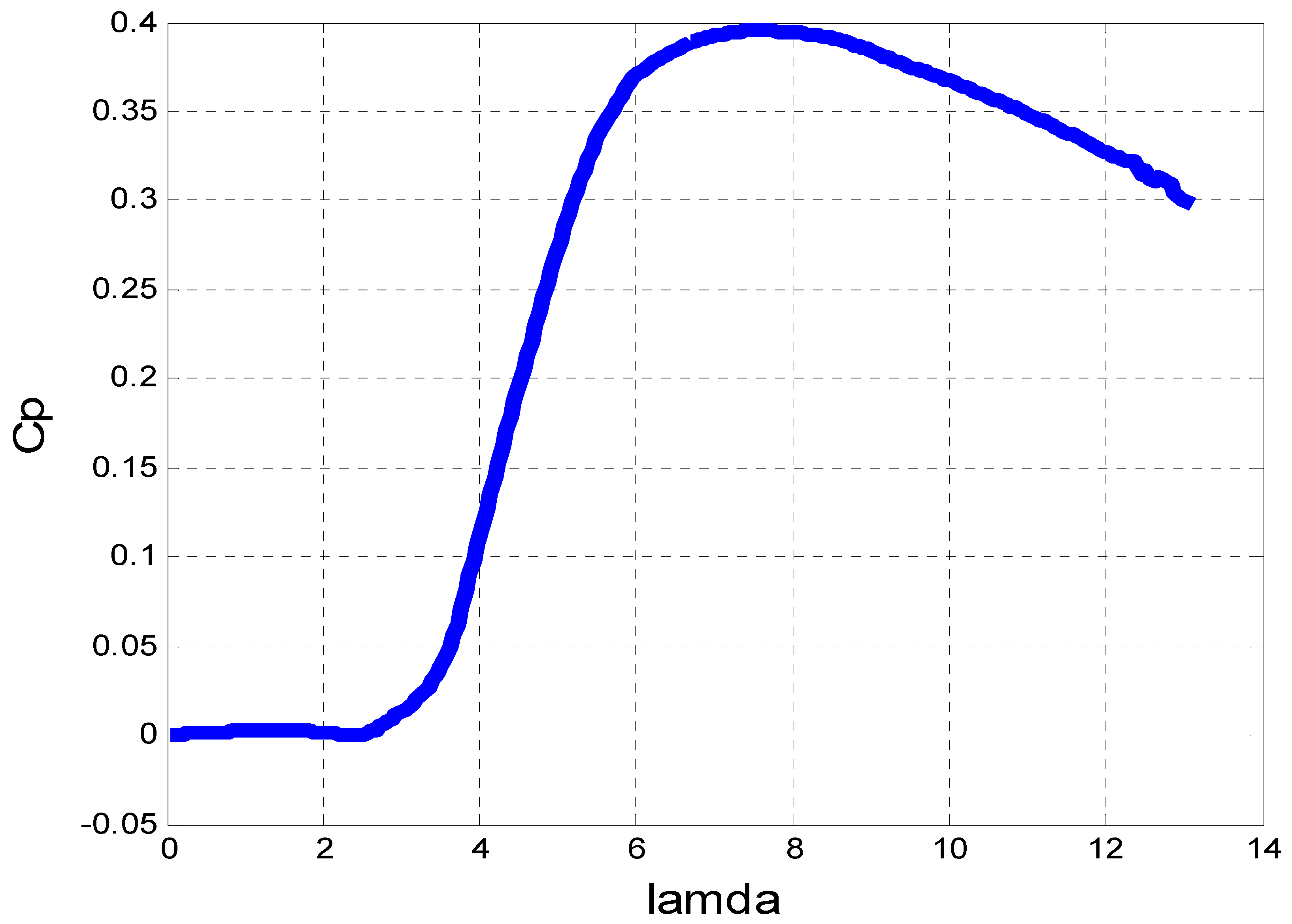

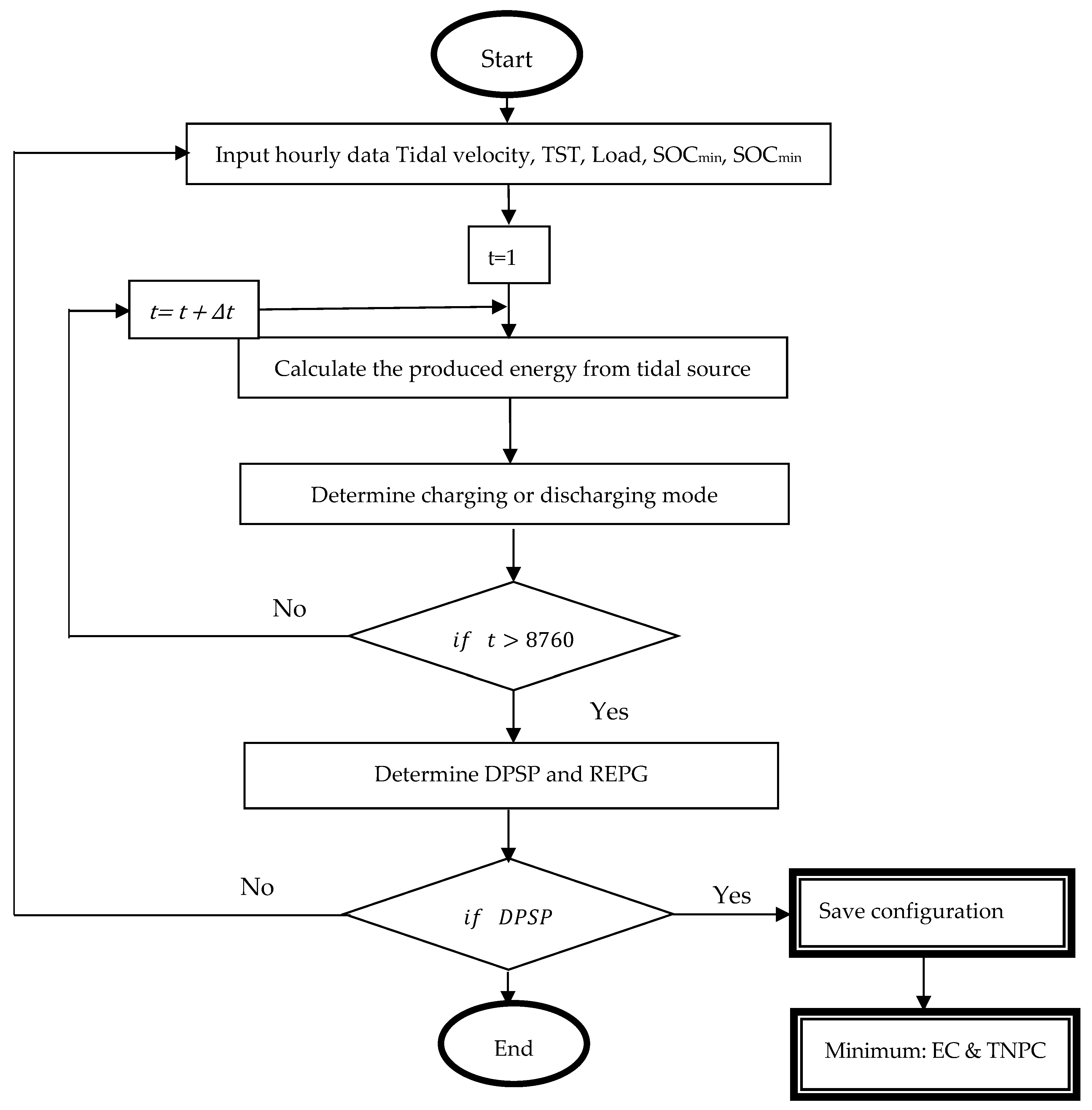
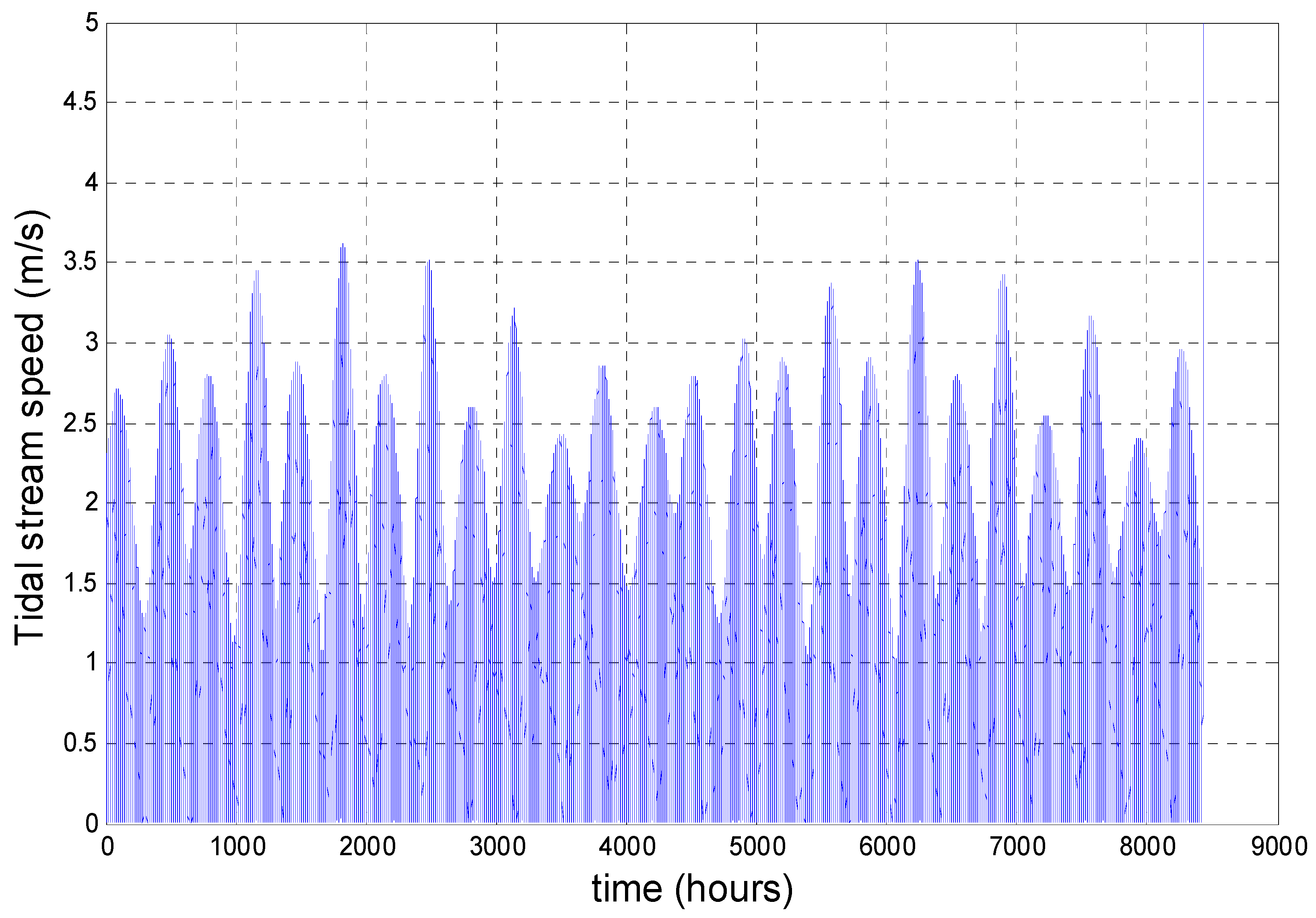

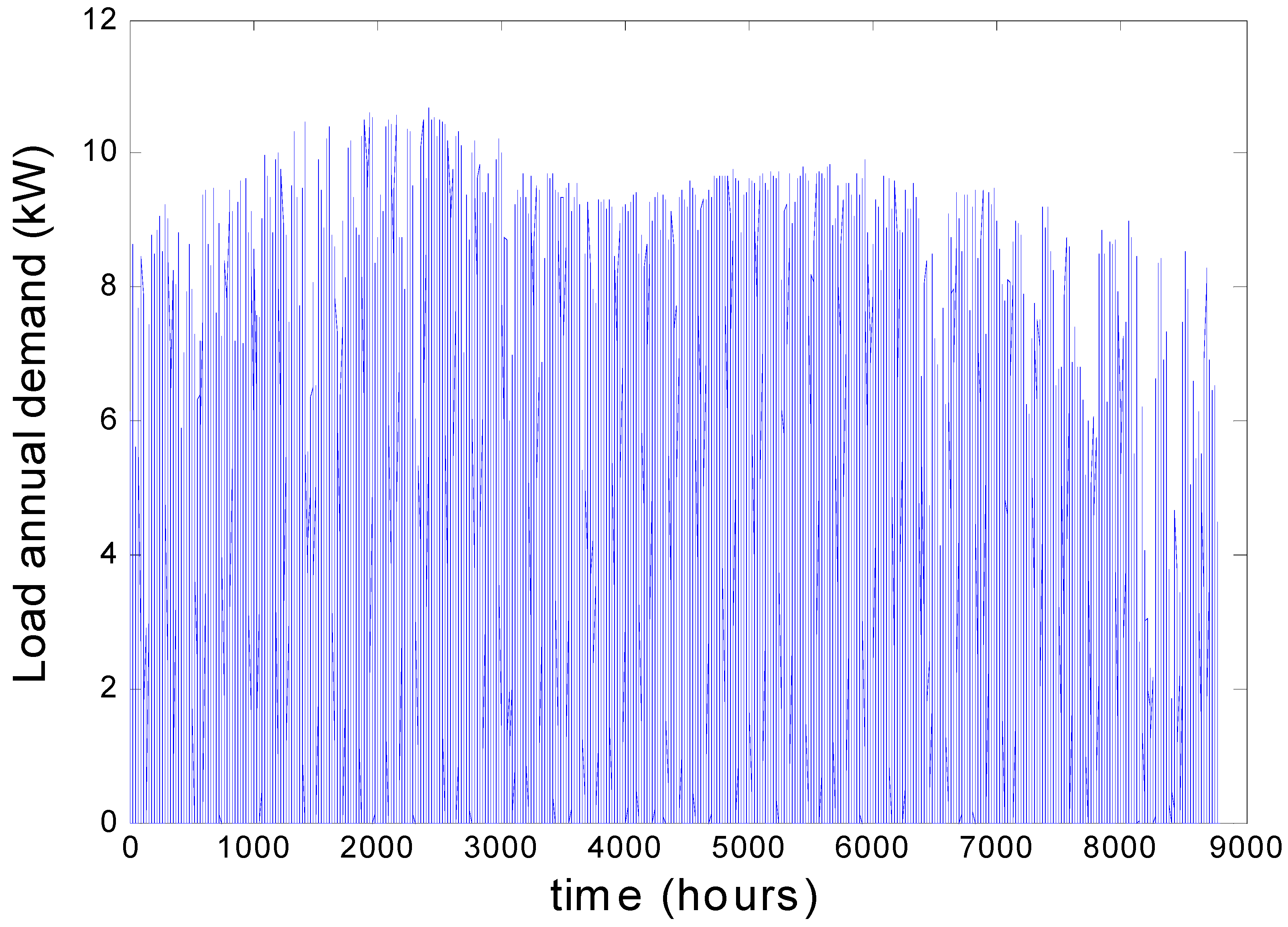
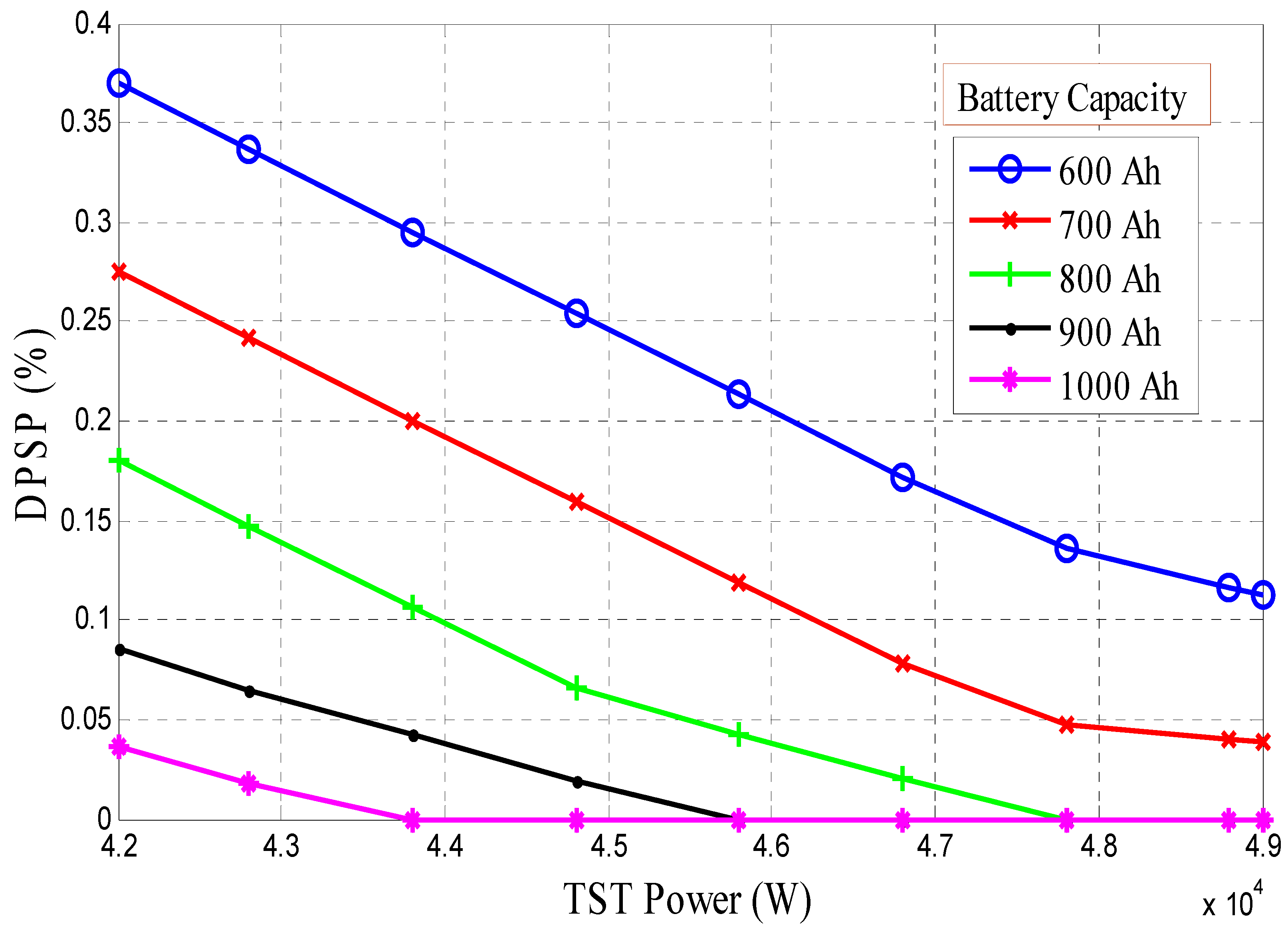
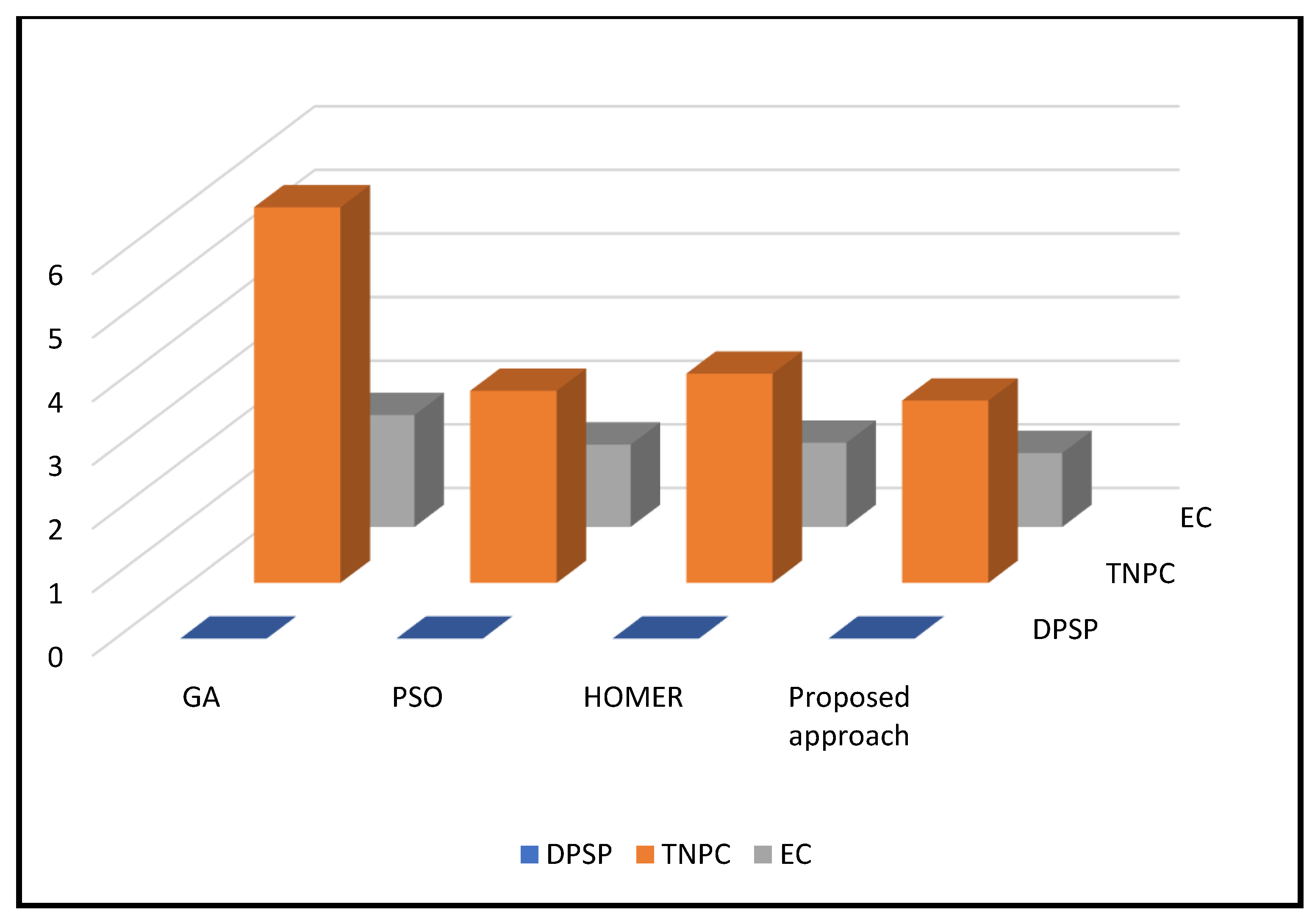
| Parameter | Value | |
|---|---|---|
| TST | Rated power | 50 kW |
| Tidal velocity | 3 m/s | |
| Cut-in tidal velocity | 1 m/s | |
| Cut-out tidal velocity | 3.8 m/s | |
| Radius | 8 m | |
| Rated speed | 25 rpm | |
| Stator resistance | 0.0081 Ω | |
| d-axis inductance | 1.2 mH | |
| q-axis inductance | 1.2 mH | |
| Permanent magnet flux | 2.458 Wb | |
| System total inertia | 1.3131 × 106 kg·m2 | |
| Viscosity coefficient | 8.5 × 10−3 Nm/s | |
| Capital cost | 5000 USD/kW | |
| Operation and maintenance costs | 150 USD/kW | |
| Lifetime | 20 years | |
| Battery | Capacity Voltage | 800 Ah 240 V |
| Efficiency | 0.85 | |
| DOD | 0.7 | |
| Lifetime | 5 years |
| TST Power (kW) | Battery Capacity (Ah) | DPSP (%) | Decision |
|---|---|---|---|
| Whatever | 600 | ≠0 | Rejected |
| Whatever | 700 | ≠0 | Rejected |
| <43.8 | Whatever | ≠0 | Rejected |
| <47.8 | 800 | ≠0 | Rejected |
| ≥47.8 | 800 | 0 | Accepted |
| <45.8 | 900 | ≠0 | Rejected |
| ≥45.8 | 900 | 0 | Accepted |
| ≥43.8 | 1000 | 0 | Accepted |
| Approach | TST Power (kW) | Battery Capacity (Ah) | DPSP (%) | TNPC (USD) | EC (USD/kWh) |
|---|---|---|---|---|---|
| Genetic algorithm | 98.52 | 2235 | 0 | 59042 | 1.761 |
| Particle swarm optimization | 53.4 | 1040 | 0 | 30200 | 1.296 |
| HOMER | 62.3 | 1100 | 0 | 32888 | 1.325 |
| Proposed approach | 47.8 | 47.8 | 0 | 28647 | 1.164 |
Disclaimer/Publisher’s Note: The statements, opinions and data contained in all publications are solely those of the individual author(s) and contributor(s) and not of MDPI and/or the editor(s). MDPI and/or the editor(s) disclaim responsibility for any injury to people or property resulting from any ideas, methods, instructions or products referred to in the content. |
© 2023 by the authors. Licensee MDPI, Basel, Switzerland. This article is an open access article distributed under the terms and conditions of the Creative Commons Attribution (CC BY) license (https://creativecommons.org/licenses/by/4.0/).
Share and Cite
Toumi, S.; Amirat, Y.; Elbouchikhi, E.; Zhou, Z.; Benbouzid, M. Techno-Economic Optimal Sizing Design for a Tidal Stream Turbine–Battery System. J. Mar. Sci. Eng. 2023, 11, 679. https://doi.org/10.3390/jmse11030679
Toumi S, Amirat Y, Elbouchikhi E, Zhou Z, Benbouzid M. Techno-Economic Optimal Sizing Design for a Tidal Stream Turbine–Battery System. Journal of Marine Science and Engineering. 2023; 11(3):679. https://doi.org/10.3390/jmse11030679
Chicago/Turabian StyleToumi, Sana, Yassine Amirat, Elhoussin Elbouchikhi, Zhibin Zhou, and Mohamed Benbouzid. 2023. "Techno-Economic Optimal Sizing Design for a Tidal Stream Turbine–Battery System" Journal of Marine Science and Engineering 11, no. 3: 679. https://doi.org/10.3390/jmse11030679
APA StyleToumi, S., Amirat, Y., Elbouchikhi, E., Zhou, Z., & Benbouzid, M. (2023). Techno-Economic Optimal Sizing Design for a Tidal Stream Turbine–Battery System. Journal of Marine Science and Engineering, 11(3), 679. https://doi.org/10.3390/jmse11030679










